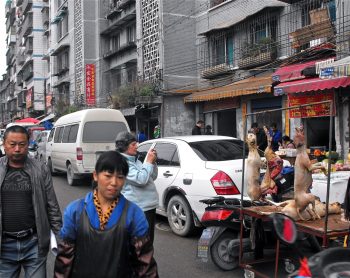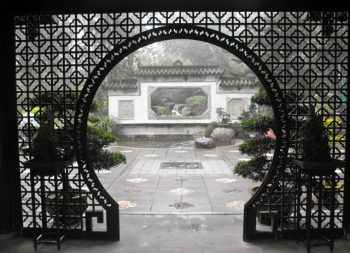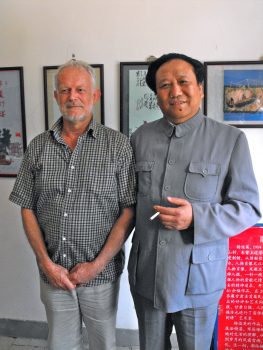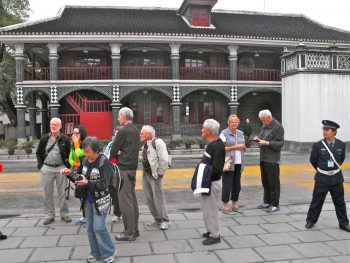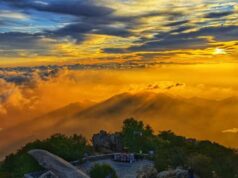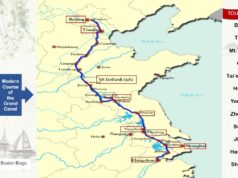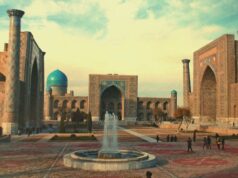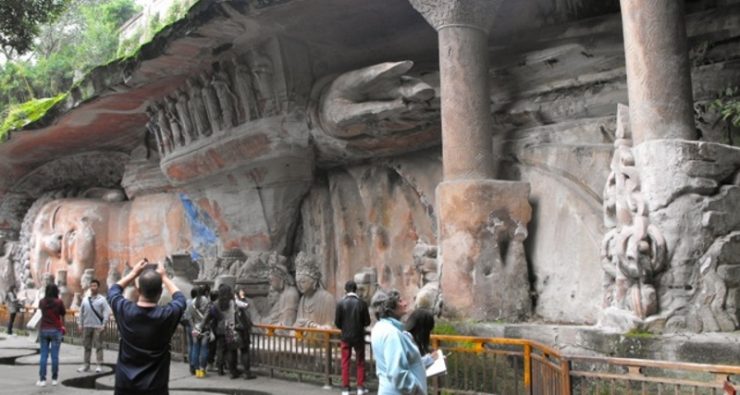
This account is my own impression of this tour. I did, however, ask for further suggestions from the other members of the group, and, where possible, I have included them. – Teri France
Our NZCFS tour, in October, 2013, was aptly named – Diverse China. The contrasts between China’s traditional and modern culture, history, agriculture, and peoples as well as the simple geography from North to South are staggering and the nine people on this trip found themselves re-assessing China and their attitude to her almost from day to day.
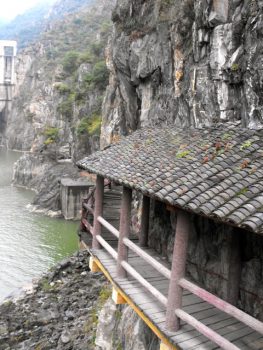
One of these striking contrasts between ancient and modern China was a visit to an ancient Plank Road, set cheek by jowl with the first hydro-electric dam erected by Mao: the Shimen dam, cunningly constructed across the river taking advantage of a narrow gap of rock, but strong enough to hold the concrete pillars of the dam. On the cliff wall of the gorge was the Baoxie Plank Road, built during the Eastern Zhou dynasty (about 250BC) and used to advantage by Emperor Qin (221-207BC) to attack and conquer the tribes to the North. Small tunnels hewn through rocks in the hillside and connecting the plank road were said to be the first in China and possibly the world. The river and landscape, containing side by side these two contrasting brain-childs of man, were quite beautiful and we walked along part of the road to admire the view.
Other ancient sites were the Terracotta Warriors close to Xi’an city, consisting of three pits, all featuring the mysterious warriors only discovered in the 1970s when a local farmer found them whilst digging a well. They were ordered by Emperor Qin, 2000 years ago, to be fabricated as protection against grave looters. They stand patiently in long rows, each soldier individually moulded with his own features, some wearing moustaches, some smiling a secret smile, some serious, but all somehow mysterious having survived for two thousand years beneath the ground before being rescued into the light of day again.
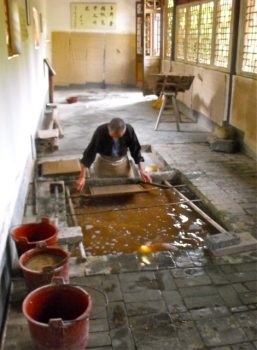
Papermaking was first invented in China (as were so many inventions…) and we got a chance to see the very place, Longting township, Yang Xian, home of Cai Lun. He lived from 62 to121AD and although writing had been invented many years earlier, information was carved on stone, rock, or bronze, making accessibility very difficult. Cai Lun (62-121AD) was a eunuch in the emperor’s court and spent 13 years researching the best way to produce an alternative to stone. Paper revolutionised the spread of information and quickly extended to the rest of China, then on to the Middle East and Europe. More surprisingly, we discovered in the gardens, an old man still making paper in the original manner, kneeling in front of a water container full of pulp made by crushed mulberry-tree bark. With a sieve, he expertly sluiced out the water to make a perfect sheet of paper. It was skilfully lined up on top of other sheets and then stuck against the wall to dry. He told us that he had been making the paper for 70 years since he was a boy of 12. Unfortunately, he had never learned to read and write which I thought was sad, but he assured us that he loved his job. Cai Lun’s tumulus is there in the garden, where he was honoured posthumously, having been falsely denounced when alive!
Another opportunity to see China’s inventiveness was at an ancient irrigation system still in use today. Farmers on the Min River in the northwest of Dujiangyan City (in Sichuan province), during the Warring States Period (406-221BC), found that this mighty river flooded in winter but fell to very low levels in summer, ruining the crops. Li Bing, the governor of Shu Prefecture in the Kingdom of Qin, designed a series of islands and man-made channels to divert much of the water when needed, to irrigate a huge area of Sichuan. This whole feat of masterly engineering was finished in 250BC and has been used every year since! The farmers of today are still benefitting from an irrigation system built 2,200 years ago and the area irrigated has expanded over the years from 126,000 hectares to nearly 600,000 hectares, covering 36 counties. Today, the Dujiangyan Irrigation Scheme is a World Heritage site and huge crowds visit the three areas where the river is divided.
In stark contrast, we saw throughout much of our trip, huge modern constructions of motorways and railways, both with many, many flyovers, bridges and tunnels (70 in all in the Qinling mountains that we counted. Some were 12km long!), being pushed along at an amazing speed. This meant that some of the roads were either still being constructed or had suffered recent erosion by floods and sitting in a small poorly-sprung bus was not always a comfortable ride. However, the new road system even extends into the smallest hamlets we visited, thus ensuring, perhaps, that nobody in China is isolated any more.
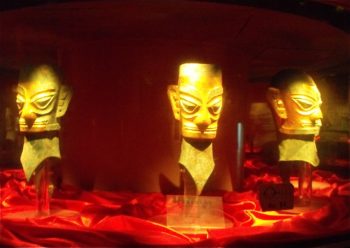
The famous Bronzes at Sanxingdui were discovered in 1930s, and a museum comprising several buildings contain these amazing bronze statues. When one thinks that these bronzes were made about 3000 years ago, they are remarkable for their perfection of detail. The process of bronze manufacture came much later in the west, but, in fact, these Shang dynasty bronzes are very similar in style to Mayan civilisation artefacts and the Sanxingdui sacrificial site mirrors the stepped pyramids so well known in that civilisation.
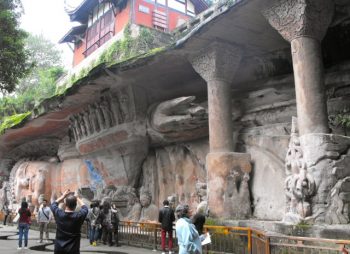
The beautiful Da Zu Buddhist statues, near Chongqing, were definitely worth the long drive through countryside, the sky grey and hazy. The 5,000 statues, including a 33m long reclining serene Buddha, are carved into the rock and many of them depict scenes from the story of that faith, some of them, surprisingly, visions of hell in the form of bodies cut in half and other threats of punishment perhaps to recalcitrant believers! Many of the statues, which stretch over a huge area, were several metres high, and many have traces of highly coloured paint, which over the 900 years since they were carved give a hint of their original brilliance.
In stark contrast, we visited the extremely modern Revolutionary Memorial museum of Yan’an (in North Shaanxi province). It is dedicated mainly to the Communist Army’s arrival in Yan’an after the Long March when thousands of men, women and children joined along the way to escape from the Nationalist Guomintang. Huge photos in every hall feature Mao (in colour) and all the other leaders, and wall-size dioramas, show the countryside during the March with Mao and others in the foreground. We saw another modern dedication at Zunyi, in Guizhou province, where the Communists had a critical conference to decide on policy, at the start of the Long March: Komintern advisers were uncomfortable with encouraging the peasants to rise up, but Mao was adamant that, despite the Russian advisers disagreeing, this was the way that the uprising should go. It was effectively the start of Mao’s ‘reign’.
One day, we left our bags at The Worker, Peasant, Soldier Hotel just outside Chengdu. One can guess what type of hotel this was and one would be correct! The toilets in the rooms were ‘holes in the ground’ type, something fairly alien to the cosseted Westerner, and some of the tour members thought that a four-star hotel would have been preferable, especially for more mature people. The foyer and staircase were decorated with photos of local communists as well as inspirational revolutionary art. In contrast, the day was spent visiting the Missionary Museum near Chengdu, where visitors got a chance to see photos of the massive contribution of educational and medical support during the Qing dynasty and Republican China, made by 1000 Canadian missionaries, including the parents of NZCFS member, Bill Willmott. Also of interest was the Foot Binding Museum and the Manor House of Liuo Wencai, a feudal landlord.
We were struck by the number of art-forms which abound throughout the country, such as the huge (150m long!) granite sculpture alongside the motorway service station in the Qinling mountains, somehow come upon by accident. It features Emperor Qin in huge formation alongside his terracotta soldiers, ships, farmers hoeing the soil and many other fascinating forms. Another example was the row of statues featuring a wagon train of people travelling through the countryside bearing produce on horseback as we walked along the ancient Long Yin Gorge footpath, again in the Qinling mountains. This was near the ancient town of Huayang.
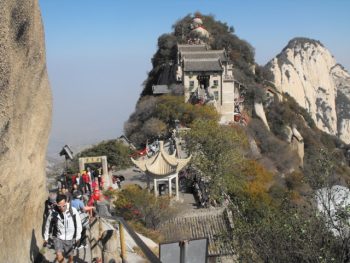
We also got a chance to see Huashan, one of China’s five Sacred Mountains with a long history of religious significance, in the Qinling mountains, and took the ski ride to the top of one of the peaks. Our intrepid leader and a friend were determined to climb the hundreds of steps to four of the five mountain peaks, access being over the frightening Dark Dragon Ridge. This they achieved, tired but triumphant, as the rest of us decided to mount a number of steps that abounded along the ridges and then enjoy the amenities provided by cafes clinging to the ridge .
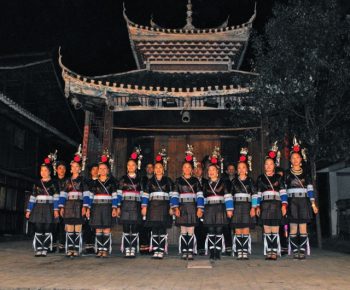
The culture of China abounds in shows, light festivals and boat trips as well as paintings and art and we had an opportunity to enjoy several of these. We visited several Dong ethnic minority villages to see how the people live. Fortunately, most were not touristy and to see the people’s way of life was fascinating. The Dong women still wore their traditional dress, of embroidered apron and dark blue skirts, their extremely long hair oiled and bound up with combs on top of their heads and we attended a show in the evening at one village in which we listened to their songs in their language and the playing of traditional instruments. We were then invited to join them in a circle on the small stage in the town square.
Boat trips on the Guilin River Li are, by contrast, more touristic and we took a boat along the river filled with people chattering and eating. This was quite different from a previous trip we had taken a few years ago when the river was much quieter with almost no visitors in sight as we glided along on a bamboo raft in the quiet, watching the local fishermen with their cormorants who have been taught to catch fish for their owners by regurgitating their catch. However, the show put on by the local people in Yangshuo, near Guilin, was nothing short of spectacular.

The backdrop was a number of sugar-loaf mountains carefully lit up against the dark sky in a bend of the river. Beautiful ladies in traditional dress glided along the water, in boats plied by the men, also in traditional dress. Suddenly, waves of red cloth appeared and the men in their boats shook them violently to represent a violent storm. Scenes from a local folk story were enacted with fabulous lighting and music and were marvellous to experience. We came away very happy that evening.
The landscape and agriculture of China is also very diverse, varying from low farmlands full of sweetcorn, careful strips of private garden plots featuring greens and vegetables impeccably tended with not a weed to be seen. By contrast, the mountains of South China demonstrated the careful work done over the centuries to wrest produce from the steep slopes. This has been achieved by extensive terracing – a careful layering of the mountainsides which are irrigated by streams alongside each terrace. It was amazing to see people toiling away on paddy fields at great heights and one wondered how far away they were from home and if they had a long journey back each day after a hard day’s toil in the fields. The golden yellow fields in the sunlight were delightful.

We also got a chance to feed some wild Golden Snubnosed Monkeys one day – a very odd sensation! Looking into the eyes of a monkey is like looking through a mirror – so human in their responses. “Will she give me another peanut”? “Shall I grab another one or wait till it’s given”? “Better watch out for Mr Big over there”!
We also saw some endangered Crested Ibis. This species was down to a mere 7 birds in the 1990s, before being rescued from extinction by a Shanghai academic who highlighted the problem, and so began the long journey back to more viable numbers.
To finish, this story would not be complete without discussing the people of China. A more diverse mixture we could not wish to have met. The first group that come to mind were the police when we were travelling through Huanglong County. At a toilet stop, two of us were approached by two policemen and told we were in a Forbidden Zone and “would we please get in the police car”! For more on this story: Click here!!

In sharp contrast, our visit to the Nan Zheng Palm Frond Co-operative couldn’t have been more enjoyable. The members made us thoroughly welcome and showed us the products that they produce from palms grown in local forests. With the help of NZCFS and the Chinese Women’s Federation, they have increased their membership from 35 people and 10 families in 2012, to 247 members and 20 families at present. Their income has now grown to 6million RMB per annum.
One startling aspect of China though, is the way almost everyone works outside, often on the pavement. People in a Dong ethnic minority village, Che jiang, worked in the village centre, sawing timber, constructing pieces of bamboo for the flute maker nearby who assembled the flutes and checked them for the right notes, and women washing in the pond whilst the young boys swung their pony tails, a small island of hair where the rest of the head was shaved. At another Dong village we came upon a lady weaving beautiful braid on a loom, and further down the street, two more in their doorways sewing ethnic dresses.
More worrying were the people behind one of our hotels, who we came upon during a walk, cutting meat and fish up on the pavement. Carcasses of dogs were strung up nearby and hundreds of chicken bodies were piled in a corner as well as terrapins and frogs. Such livestock strewn across the pavements was a bit of a culture shock, especially as they were being chopped up whilst still alive in some cases! Ironically at the other extreme, round the corner, senior citizens were dipping long brushes into water and writing poems on the pavement in beautiful calligraphy, before it was walked upon by workers hurrying to their place of business.
And to finish on a peaceful note, two of us suddenly came upon an exquisite garden, a quiet oasis in the middle of the hectic tourist crowds at Dujiangyan, hidden away in a silent corner. So Chinese in style, it was deliberately constructed to surprise one on turning the corner.
Certainly a diverse place, this China!
Teri France, November 2013
For a complete itinerary, with hyperlinks to more background information about many of the locations visited click here.


